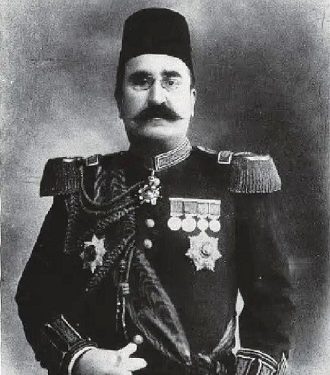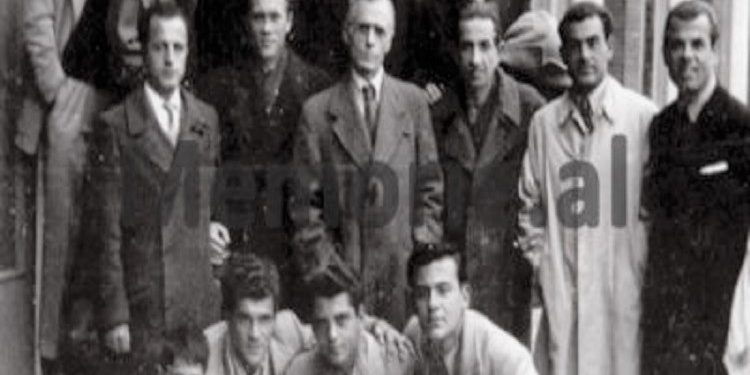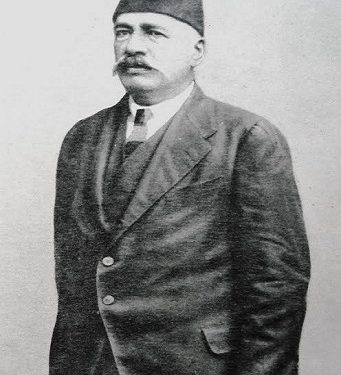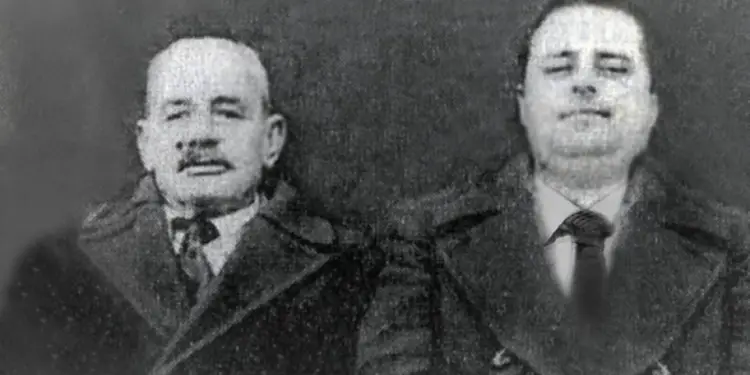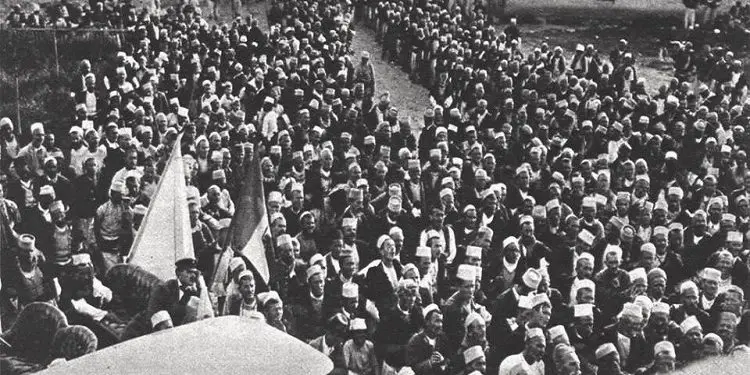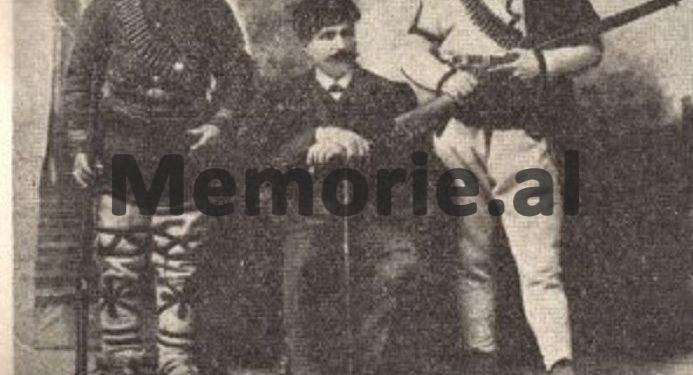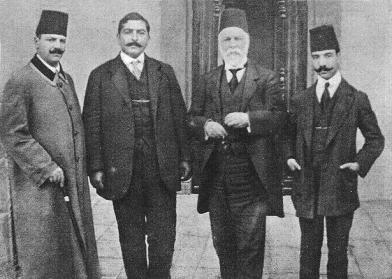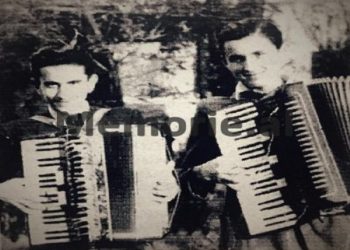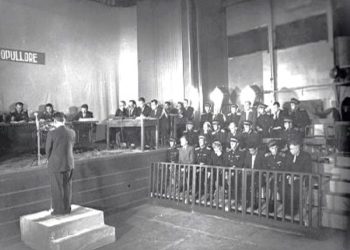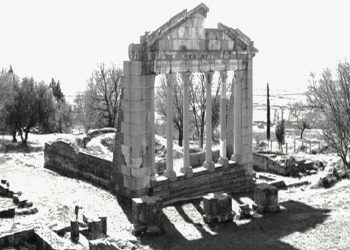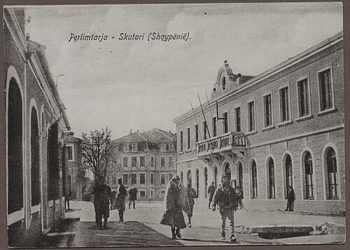By Sejfi Vllamasi
The fourth part
Memorie.al / From all the provinces of Albania, people’s delegates and a majority of patriots arrived, from inside and outside Albania, and on November 28, 1912, amid great enthusiasm, after 450 years of captivity, the flag was raised national and the independence of Albania was declared. A government was formed under the chairmanship of Ismail Qemali, in which Preng Bibdod Pasha also participated as deputy prime minister and Esat Pashë Toptani as minister of the interior. When Ismail Qemali arrives in Vlora, Seit Qemali, Murat Tërbaçi, Alem Mehmeti and many other patriots, as reservists, fought against the Greek army in Llogara. These, upon being informed about the purpose of the Elder’s arrival in Vlora, raised the national flag at the front of the war, before it was raised in Vlora.
Continues from last issue
Ethem bey Starova, has been against the voluntary powers. The rebels, after entering Pogradec, went to Ura e Maliqi. They stopped here as they considered this point to be the border between Albania and Greece. Before the successive successes of the insurgents, Vidi and his members became alarmed and, in order to secure volunteer forces, to suppress the insurrection, they knocked on every door, starting with the great doors, in which Vidi has been based. After the failure of the insurgents’ attack against Durrës, on June 15, the government, which has sufficient funds, began assembling volunteer forces.
This is how 1,200 volunteers arrive in Durrës in the morning under the leadership of Marka Gjon. Preng Pasha, at the head of a force composed of Shkodrans and mountaineers took Ishmi. The bird with a power of Matjans, arrives in the vicinity of Kruja. Aziz saw Vrioni, with the volunteers of Berat, as well as the volunteers of Vlora and Mallakastra, going towards Lushnja, to free Durrës from the siege of Ahli-Kijam. Bajram Curri sent the highlanders of Kosovo by sea, from Shengjin to Durrës.
Both for Mirdita’s volunteers and for other civil forces, the military authorities wanted these forces, for ease of action, to be divided into detachments, accompanying each of them with 10 gendarmes. But Marka Gjoni did not accept this and without taking any security measures, attacked Rrashbulli. The insurgents, who had descended at the foot of Rrashbulli and were, hiding in Shkozet, met the Mirditas with a severe fire, defeating them with great losses. I myself have witnessed this war, from the beginning to the end. On the other hand, Preng Pasha occupied Ishmi, but, when the vanguard of his forces were moving towards Shijak, he, fearing the siege by the rebel force coming from the Field of Kruja, quickly retreated to Lesh.
Zogu, who was waiting in Kruja for the attacks of Marka Gjon and Preng Pasha, after their defeat retreated to Mat. On the other hand, the rebels, after defeating the forces of Aziz Pashë Vrion, occupied Lushnja on June 11 and reached the Devolli River.
The volunteer forces of Mallakastra and Vlora, commanded by Major Besim Koka, with Hysni Toska on the right wing and Bektash Cakran on the left wing, were getting ready to enter Lushnja in the Monastery of Ardenica. The leader of the rebels, Arif Karbunara, who was a nationalist-inspired patriot like Ibrahim Karbunara, compromised with the central government powers, telling them that he would back down, to leave them a free way to enter Lushnja.
Besim Koka was also the commander-in-chief of the volunteer forces. This, despite all the facilities that Sheh Karbunara made to enter Karbunare without a fight, bombarded Lushnja and left the volunteers free to plunder the people; in a word, he did his best to sabotage the war, which would surely be won. The rebels and the people, enraged by the bombardment, attacked the government force and forced it to retreat with great damage, Seit Qemali also being injured. The retreating government forces were shot through the fences of the houses, by oppressed musketeer farmers, who on this occasion spontaneously showed their hatred and anger against the feudal lords and their powers.
Bektash Cakrani stayed in place and did not advance, while Hysni Toska fought bravely, leaving many dead, including Riza and Godo Hekal, both grandsons of Rrapo Hekal. On July 12, 1914, the insurgents occupied Berat and Fier, which was bombarded by Bektash Cakran.
In Berat, three patriots were executed by the rebels: Captain Baki Gjebrea, Hajredin Fratari and Ismail Klosi. On August 13, Berat was occupied again, by immigrants from Korça and Gjirokastra. In this war, Čerçis Topulli also participated, but on August 19, the city was preoccupied by the rebels, who occupied Vjosa and made preparations to enter Vlora.
The “Vorio-Epirote” Uprising
For the organization of the Albanian gendarmerie, it was designated by the London Conference and a Dutch military mission had arrived in Albania, headed by General Dewer, with Colonel Thomson as vice president. In the composition of the mission, there were also other officers of various ranks. These officers, in cooperation with the Albanian officers, organized the gendarmerie for the free villages and at the same time, in anticipation of the liberation of the villages still held by the Greeks and Serbs, they prepared a battalion for each prefecture.
For Korça and Gjirokastra, the battalions were respectively commanded by Major Mustafa Aranitasi and Major Ismail Haki Tatzati. When the Greek government decided, constrained by the Great Powers that had determined the borders of Albania, to withdraw its occupation powers from Korça and Gjirokastra, the Albanian government launched its gendarmerie battalions, together with the prefects and heads of predetermined offices, to take regular delivery of those prefectures. Regular delivery was made to Korça, Erseka, Tepelena, a part of Dangelli, Këlcyra and a part of Kurveles.
From the middle of March, the Albanian government sent 300 gendarmes under the command of Mustafa Spathara, with two Dutch officers, who marched from Opari to Voskopojë and Korçë. The Greek army surrendered Korça and headed for Bilisht and the border. But the Greeks in Korça began to implement the plan of the uprising that they had prepared before, and on April 2, 1914, the uprising broke out in Korça, organized by the Greek agent, Jakov, Dhespot of Korça, and by the council of the Metropolis. This plan was implemented by the Greek volunteers of the city and the field, under the command of captain Sulos, as well as by the Greek soldiers, hidden in Korça, who occupied the most important positions of the city.
At the same time, the dedication was given among the villages, in which the patriots began to gather and organize. The forces of Kajo Kapedani were placed under the vineyards of Korça, where they defeated the forces of Jorgji Busho, the former deputy of Serfixha in the Ottoman parliament, which were marching towards the city. On the other hand, the villagers of Mborja, in Gryka e Mborja, destroyed the power of doctor Harisjad (korçar), consisting of 400 people. Thus the city was liberated and the Despot with the Metropolitan Council was transferred to Elbasan.
The extremist nationalists of Korça, enraged by the treachery of the Greco-Romans of Korça, wanted to burn the city, but the intervention and coolness of Abdyl Ypi saved the city from the danger of fire. The national powers violated Devolli, Arrza, Nikolica and Dardha. Major Ismail Haki Tatzati made Hoçishti the center of action. Bilishti remained in the hands of the Greeks. In Korça, the administration was stabilized with prefect Pandeli Vangjelin, assistant prefect Abdyl Ypin, presiding judge, lawyer Kasnecin (himariot), police chief Themistokli Gërmenji and police commissioner Hysen Nikolica.
When this orderly but deliberately slow handover by the Greeks continued, the Vorio-Epirote autonomy came on the scene. The Greek command suspends the surrender of other countries, on the pretext that, after the people of those countries declared autonomy, it had no opportunity to impose on them the union and submission to the Albanian Government, therefore it (the Greek army) withdraws to the designated borders from the London Conference and leaves the Albanian Government to regulate its own affairs with the government of Vorio-Epirot autonomy.
This situation caused Albania to use weapons, not only to liberate the rest of its land, but also to protect those that it had taken in orderly surrender from the Greek army, shedding the blood of its sons. The Albanian gendarmerie, after taking over Erseka, based on the agreement with the Greek command of the successive handover of the countries it was occupying, set out to take over Leskovik as well.
But, when it reached the vicinity of Leskovik, it was suddenly greeted with fire by the powers of the Vorio-Epirote government, which, according to the decision of their government, did not obey the decision of the London Conference, for the union with Albania of the prefectures of Korça and Gjirokastra. This government demanded union with Greece or, at least, such autonomy that was equal to union with Greece, supporting its demands, among others, with the claim that the majority of the population of the two prefectures (Korçë and Gjirokastër) consists of Christians, so according to the Greek saying; “pan orthodhoksos kristianos, ine elinos”, from the Greeks.
This form of government was established by the Greek Government, put into action by it, paid by it, supported politically and militarily by it. The head of the government himself was the former prefect of Greece, with Albanian nationality from Qestorati, the Minister of the Interior; he was the major of the Greek gendarmerie, with Albanian nationality, from Nivicë-Bubari.
The Albanian gendarmerie that would take over Leskovik, consisted of one company (nearly 120 people). Faced with an unexpected situation and faced with much greater forces and more means, she, after a fierce effort, leaving about 20 dead, including Qani bey Starjen and several others wounded, was forced to withdraw together with the volunteer forces, which had come to his aid since the first shots of the rifles, to the Gërmenj-Radom line, in order to hinder the advance of the Vorio-Epirote forces and to receive new instructions on the situation created.
The autonomous powers consisted of non-Rollohite guilds (sacred companies), which had been recruited from local Christians, trained, armed and equipped by the government and officers of the Greek regular army, from before. Andars (committee) were troops called volunteers, composed of insurgent detachments of Epirus, Macedonia and Crete, who had fought in the time of Turkey and were now kept in reserve, for any kind of adventure. In addition to these, among the Andart units, there were also units of the regular Greek army, which it had deliberately left in place and which it had formally declared as deserters. These, like the others, were equipped and armed to the teeth.
The same thing happened with the gendarmerie of Gjirokastra, which, sent from Tepelena to take over that city, encountered in the vicinity of Han i Subashi, as well as with the gendarmerie forces destined for Përmet, stopped beyond Këlcyra, from equal Vorio-Epirote powers. Here too, the Albanian gendarmerie was forced to retreat and, reinforced with volunteers, to defend itself near the Hani Vjosë-Hormovë e Shtepëz line. Thus began the first armed conflict between the Albanians and the troops of the northern-Epirote autonomy, with very bitter consequences for the Albanian people, who during the period of subsequent fighting, showed selflessness, bravery and courage, in very difficult circumstances for the union of its mutilated land and for the brotherhood of the religious elements that made it up.
In April 1914, the Albanian gendarmerie was reinforced with volunteer units, composed of several countries of Albania and, especially, of the local population, enthusiastic but disorderly, undisciplined and especially, unequipped, because they lacked ammunition and food. But the biggest lack was that of the leading and coordinating command. With all these shortages, it was decided to undertake a general offensive. The purpose of this offensive was the liquidation of the northern Epirote autonomy and the liberation of the countries that were still under its power.
The main objective was Gjirokastra, the center of the Vorio-Epirot Government, as it was thought that with its capture, any open resistance and with it the existence of autonomy itself, would end.
Thus the offensive began in many directions. The main one was Tepelen – Gjirokastër, helped by the Labovë – Libohovë offensive. The others were Kuc – Himare, Qafa e Skërfica – Delvinë, Këlcyre – Përmet – Frashër – Leskovik and Gërmënj – Leskovik. Out of all of these, only that of the Monastery of Cepos – Gjirokastër and that of Qafa e Skërfica – Delvina, almost reached the goal. The vanguards of the first arrived at the Virua River and of the second, in the “Rusant” neighborhood of Delvina. Other columns had some minor successes and were soon forced to halt their advance.
From these initial successes of the Albanian arms, which caused the destruction of the forces of autonomy, the autonomous government was preparing and getting ready to flee; part of the Greek-speaking population began to emigrate to Ioannina, Corfu and elsewhere. The Greek government was also preoccupied by the successes of the Albanians, which jeopardized its entire plan to separate Epirus from Albania.
For that reason, he decided to quickly send the regular troops of the Ioannina Division to the aid of the Autonomous Government, declaring them as fugitives. These troops arrived quickly at the front of the fronts and after some efforts; they were able to defeat the Albanian troops, which, as has been said, consisted of a few gendarmes and the majority of Bashibozuks, which re-stabilized the front on the previous lines of departure.
For a while, the war seemed to end, because the Albanian Government entered into talks with those of autonomy in Corfu, to find a peaceful solution to the issue of Epirus. Between these times, the Greeks were preparing, in the event of the failure of the Corfu treaties, or in the opportune case, to take the offensive to re-occupy the rest of Epirus, which was in the hands of the Albanians, and reach the line; Accounts – Salary – Kiçoku’s Neck – Ostrovce e Maliq.
The event expected by the Greeks did not delay. In Central Albania, the Esadist uprising broke out against Vidi and the national government. This spread little by little, so much so that the rebel powers managed to occupy Berat, Elbasan, Pogradec and others and threaten Vlora, which they occupied after a few days.
The national powers which were at the forefront of the war against the Greeks, happened to be baseless; not only did they have no help from behind, but they were also in danger of being attacked by the rebels, who supported the Greek claims, calling them nationalists as infidels and the cause of the secession of Albania from Baba Dovleti, for the reunification with which they were fighting.
Under these circumstances, the Greeks undertook the offensive on the entire front. The Albanian forces, facing the Greek pressure and being threatened back by the rebels and, in some places being hit by them, were defeated and took the road to save themselves and the fleeing families, “who can flee more” . They left for the provinces of Vlora, Mallakastra, Berat, in great panic.
The Greeks advanced continuously, hindered in places by the Albanians, who sought to gain time for the departure of their families, who fled only with what they were wearing. The progress of the Greeks was made in the wildest way the world had seen before the barbarian invasions. They advanced, having in one hand the bridge of fire and in the other, the sharpened knife. They burned everything that belonged to Muslim Albanians, killed all those who did not have the opportunity to leave in time, regardless of sex and age. At the same time, with the murders and burnings of Muslims, the Christians of Frashër and those villages that had made common cause with their Muslim brothers were involved. All the huts and villages that were previously liberated were reduced to rubble, and what was inside, the livestock and other things that were found, were looted.
The massacres of Panarit are to be noted. The Muslim villagers of Panarit, to escape, fled the village and passed through Backë, inside Skrapar. Together with one of Panariti’s agallars, who left with his dogs, and Stefan Panariti with his cattle? Later, Stephen returns and the Greeks convinced him to write to Aga, so that he would also return, as the Greeks ensured their freedom and their lives. Agai believes and returns. Even those who knew themselves not compromised return from the people. But one night they take the men and kill them in the vicinity of Grabocka and Melcka, they also massacre the women and children. Memorie.al
The next issue follows




